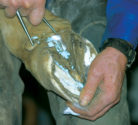Advertise Follow Us
Articles Tagged with ''Steve Norman''
Therapeutic Shoeing
Advancements in materials and techniques offer hope for serious injuries, but place premium on continuing hoof-care education
Read More
Conformation's Influence on Motion
Understanding the subtle details of a horse’s conformation will best prepare you for effective trimming and shoeing
Read More
New Track Surfaces Present Challenges To Platers
Jury still out on the best way to shoe for synthetic tracks
Read More
Dealing with Sheared Heels
The causes of this common problem may be more complex than they appear on the surface
Read More
Helping a Racehorse to the Winner's Circle
Expert farriers share trimming and shoeing techniques they’ve used to help Thoroughbreds, Quarter Horses and steeplechasers reach peak performance
Read More
Dealing with Thrush and White Line Disease
Combining topical treatments with good hoof care will help you keep these common problems under control
Read More












